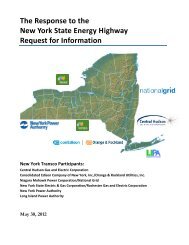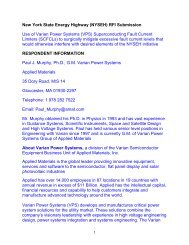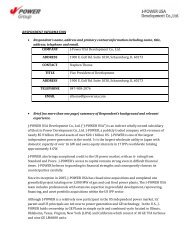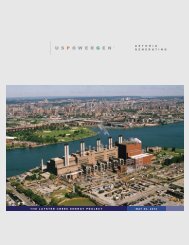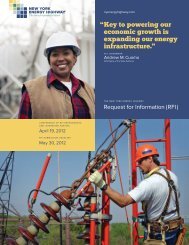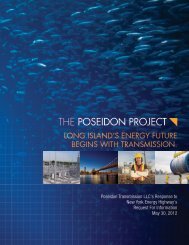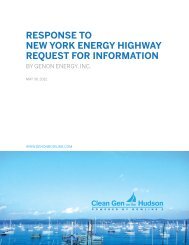Competitive Power Ventures, Inc. - Energy Highway
Competitive Power Ventures, Inc. - Energy Highway
Competitive Power Ventures, Inc. - Energy Highway
Create successful ePaper yourself
Turn your PDF publications into a flip-book with our unique Google optimized e-Paper software.
CPV VALLEY ENERGY CENTER<br />
report prepared by Strategic <strong>Power</strong> Systems <strong>Inc</strong>. and presented in an article entitled “Updating gasturbine<br />
reliability, availability”, issued in the 1Q/2012 publication of Combined Cycle Journal (CCJ), F-<br />
class turbines achieved a 91.4% availability in 2011, which is consistent for this technology. In<br />
addition, F-class turbines have a minimal forced outage rate of approximately 2.6%. It is expected<br />
that consistent with historical performance of this technology, CPV Valley will have an availability<br />
factor over 90% for dispatch starting with the first year of operation and throughout its useful life.<br />
6.2 Safety and Emergency Considerations<br />
CPV is committed to ensure safety for all workers and community members and has incorporated<br />
several design features in the facility, as well as developed procedures, to provide protection against<br />
potential safety and/or emergency events. CPV Valley will be equipped with multiple safety systems,<br />
including on-site fire protection and suppression systems, which will be designed in accordance with<br />
the New York State Fire Safety Code, and the National Fire Protection Association (NFPA) Standard<br />
101 Life Safety Code. The systems will include pull boxes, on-site fire hydrants, gas turbine enclosure<br />
fire suppression systems, portable fire extinguishers, an emergency gas shutoff valve and a sprinkler<br />
system supplied by a 1,000,000 gallon on-site raw water tank (500,000 gallons dedicated solely to fire<br />
protection). Other emergency equipment include an internal public address system, emergency<br />
lighting, stack lighting, first-aid kits, spill response kits, eyewashes, safety showers, and personal<br />
protective equipment such as hard hats, safety shoes, and safety glasses.<br />
In addition, the on-site facility personnel will be trained in fire safety and emergency response<br />
procedures and will adhere to Occupational Safety and Health Administration standards, as well as all<br />
other applicable safety standards. This training includes annual review of procedures and safety<br />
protocol. The on-site facility personnel will work closely with the local fire department and other<br />
emergency response teams to ensure that all personnel are familiar with the facility and the safety<br />
procedures that have been established. Periodic site visits will be scheduled to keep all personnel<br />
familiar with the site and to make them aware of any changes that could impact their response to an<br />
emergency.<br />
A draft Emergency Response Plan and Spill Prevention and Control Plan was prepared and included in<br />
the Final EIS. The design of the facility also incorporates several security considerations, including a<br />
fence around the site’s parameter, a gated entrance, camera monitoring and safety lighting. The<br />
control room, which is manned at all time throughout the entire year, is equipped to monitor not only<br />
the equipment and operation of the Facility, but also the security cameras and access gate, limiting<br />
access to only authorized personnel. The design characteristics and safety procedures, accompanied<br />
with strong working relationships with local emergency response personnel, result in a very safe and<br />
secure facility for both the surrounding community and the on-site personnel.<br />
7.0 Socio-Economic<br />
7.1 Benefits to the Local Economy<br />
CPV Valley will provide over $1 billion of benefit to the local economy – CPV Valley will have both<br />
direct and indirect positive economic effects on the state, town, county, and school district. These<br />
effects will begin during construction and continue throughout the operating life of the Project. The<br />
Project will result in an estimated capital investment of approximately $900 million for the<br />
development and construction of the Project. In the short term, benefits will include additional<br />
employment and expenditures associated with construction of the Project. In addition to the jobs<br />
created during construction and the wages paid to the work force, this Project is expected to have an<br />
indirect impact on the local economy through the purchase of goods and services, which will support<br />
local businesses and perhaps result in the creation of some additional new jobs. During the SEQRA<br />
approval process, an independent third-party performed socio-economic analysis to quantify the<br />
economic impacts to the region. An input-output (I/O) methodology model was used to determine<br />
the economic and fiscal impacts of the Project on the regional economy. The analysis was included in<br />
New York <strong>Energy</strong> <strong>Highway</strong><br />
14 | P age




